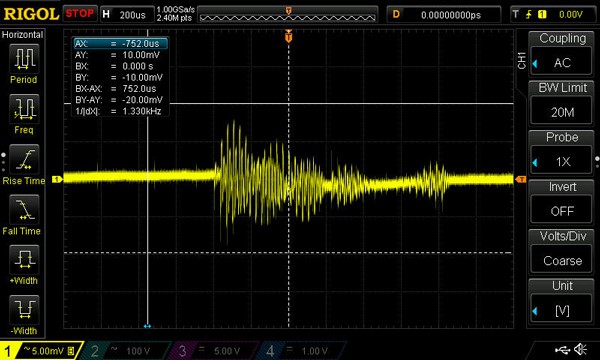PSUs 101: A Detailed Look Into Power Supplies
The objective of this article is to provide detailed information about the most crucial part of a personal computer (PC) system, its power supply unit. Follow us on this journey into PSU territory and we promise that you will gain valuable knowledge.
Measuring PSU's Fan RPM
The easiest way to measure a fan's speed or RPM (rotations per minute) is to use a tachometer. However, in the case of fans with white blades in which the laser beam of the tachometer isn't reflected properly, or when there is no visual contact with the fan blades, there is another way to measure fan speed: you can use the commutation or switching noise that the fan's motor produces. But there is a catch here. In our experience, this method works well only with fans that have increased commutation noise, and these are usually the ones with double ball bearings. In addition, you need an oscilloscope.
Utilizing Commutation Noise To Measure Fan RPM
Before we proceed to our methodology of using commutation noise for fan speed measurements, let's discuss first what produces this noise. The explanation is pretty straightforward: each fan has a number of stator coils (usually four) in its motor assembly, which are responsible for the fan's rotation. In each transition from one of the above coils to the next in line, there is a sudden torque pulse to the fan's rotor right at the time when the next coil switches on. This pulse causes a switching noise that can be measured easily with an oscilloscope. According to Noctua, high levels of commutation noise can cause a minute deformation of the whole fan structure and lead to increased noise output. This means that lower commutation noise leads to a smoother transition between the fan's coils, which in turn can lead to a quieter operation.


With an oscilloscope, the first thing to do is connect one of the instrument's probes in parallel with the fan's power source and select AC couple, in which only AC signals are allowed to pass through. Afterward, you should configure the volt and timescales in order to have a clear shot of the commutation spikes that the fan's motor produces. After you configure your scope, the only thing left to do is to measure the frequency between two sequential spikes. Every scope can do this automatically, but we chose to do it manually in order to provide you with an example that's easier to follow.
In our sample fan, at full speed, the frequency of the spikes was 160.2Hz. If we multiply this number by 15, we have the speed of the fan, which at the given moment was 2403 RPM. Easy, right? The only thing you have to do is multiply the measured frequency by 15 (60/number of stator coils = 60/4 = 15). If your scope supports math functions, this can be done automatically and provide you with the fan's speed in RPM right away.
Get Tom's Hardware's best news and in-depth reviews, straight to your inbox.
Current page: Measuring PSU's Fan RPM
Prev Page Other Bearing Types: SSO, Rifle, Hysint Next Page PSU Protections
Aris Mpitziopoulos is a contributing editor at Tom's Hardware, covering PSUs.
